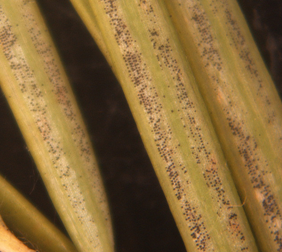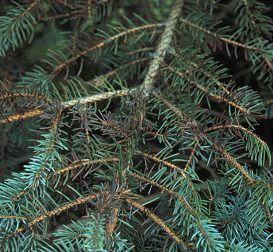What is Swiss needle cast?

Swiss needle cast is a fungal disease of Douglas-fir. This tree is native to the Rocky Mountains and the Pacific Coast but has been grown in Wisconsin as a landscape ornamental and as a Christmas tree. Swiss needle cast can limit the aesthetic appeal of Douglas-fir grown in landscape settings, as well as the marketability of Douglas-fir grown in Christmas tree production.
What does Swiss needle cast look like?
Infected needles become discolored (blotchy yellow-green or completely yellow) and then brown from the tips. Older needles are more severely affected than younger needles. Brown needles drop prematurely, leaving twigs with only the newest growth. Using a hand lens, small, black reproductive structures of the Swiss needle cast fungus can be seen in two diffuse bands on the undersurface of infected needles.
Where does Swiss needle cast come from?
Swiss needle cast is caused by the fungus Nothophaeocryptopus gaeumannii. Spore production, needle infection, and symptom development are favored by wet environmental conditions (e.g., rainy weather). Infections primarily occur on new needles as they emerge and expand in the spring. Fully expanded needles are less susceptible to infection. Once infection has occurred, fruiting bodies (i.e., reproductive structures) form and produce spores on both discolored and green needles. Spores may be produced for several seasons before needles drop.
How can I save a tree with Swiss needle cast?
Infected needles cannot be cured. However, fungicide sprays containing chlorothalonil or mancozeb may help prevent additional infections on small trees where complete, uniform coverage is possible. Fungicide treatments are not recommended for large trees. For plantation and landscape trees, apply two fungicide applications, the first when buds are ½ to two inches long, and the second about three weeks later. In the more stressful environment of nurseries, trees may require sprays every two weeks through mid-August. Using preventive treatments, infected trees may regain their lush, full look within two years. Be sure to read and follow all label instructions of the fungicide that you select to ensure that you use the product in the safest and most effective manner possible.
How can I prevent Swiss needle cast in the future?
Use Douglas-firs grown from seed originating in Pacific Coast areas rather than those grown from seed originating in the Rocky Mountains. Pacific Coast trees appear to be less susceptible to Swiss needle cast. Also, use resistant and tolerant varieties where available. Purchase stock from a reputable nursery; Nothophaeocryptopus gaeumannii is often spread through infected nursery stock. When planting Douglas-firs, choose a site that has well-drained, but moist soil with a neutral to slightly acidic pH and allow adequate spacing between trees to promote increased airflow and quicker drying of needles. This drier environment is less favorable for infection and disease development. Make sure trees have sufficient water and are fertilized properly (based on soil and needle nutrient tests) to reduce stress that may increase trees’ susceptibility to Swiss needle cast.
For more information on Swiss needle cast:
Contact the University of Wisconsin Plant Disease Diagnostics Clinic (PDDC) at (608) 262-2863 or pddc@wisc.edu.
Authors: Ann Joy and Brian Hudelson, UW-Madison Plant Pathology
Last Revised: 03/02/2024
D-number: D0109
References to pesticide products in this publication are for your convenience and are not an endorsement or criticism of one product over similar products. You are responsible for using pesticides according to the manufacturer’s current label directions. Follow directions exactly to protect the environment and people from pesticide exposure. Failure to do so violates the law.
Thanks to Diana Alfuth, Thad Kohlenberg, and Judy Reith-Rozelle for reviewing this document.
A complete inventory of UW Plant Disease Facts is available at the University of Wisconsin-Madison Plant Disease Diagnostics Clinic website: https://pddc.wisc.edu.
Send a Plant Sample for Analysis
Be cautious when self-diagnosing plant health issues. Very few diseases can accurately be diagnosed by eye.
Contact the UW Plant Disease Diagnostics Clinic (PDDC), and for a small fee, clinic staff can examine a plant, determine the cause of the disease/disorder, and provide advice on how to control or prevent the issue.
Download Article





 Rhizosphaera Needle Cast
Rhizosphaera Needle Cast Conifer Disease Quick Reference
Conifer Disease Quick Reference Dothistroma Needle Blight
Dothistroma Needle Blight Weir's Cushion Rust of Spruces
Weir's Cushion Rust of Spruces


